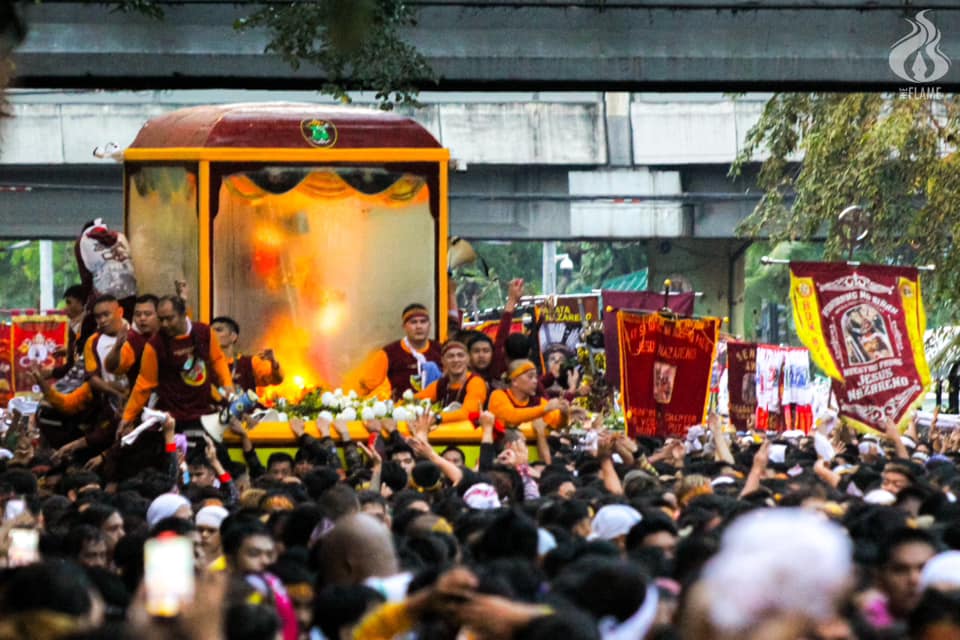
MILLIONS OF Catholic faithful took part in the Traslación of the Black Nazarene on Tuesday, Jan. 9, after a three-year hiatus due to the pandemic.
The tradition is celebrated every year to commemorate the transfer of the 400-year-old statue of the suffering Christ from Intramuros to the Quiapo Church in 1767. It passed 20 streets in Manila and lasted almost 15 hours, arriving at the Quiapo Church at 7:45 p.m.
Through this year’s procession, which carried the theme, “Ibig po naming makita si Hesus (We wish to see Jesus),” devotees were finally able to express their devotion, which was suppressed during the height of the COVID-19 health crisis. Among the practices believed to grant miracles and heal illnesses was the traditional pahalik or the kissing of the image, which was held from Jan. 6 to 8 at the Quirino Grandstand.
But despite the celebration carrying centuries-old traditions and acts of faith, several misconceptions still surround the Traslación.
Not the Feast of the Black Nazarene
The Traslación or the procession of the image of Jesus carrying his cross, differs from the Feast of the Black Nazarene even if the two events are often lumped together.
The actual Feast of the Black Nazarene is on Good Friday, which commemorates Christ’s suffering and death during Holy Week.
Meanwhile, the Jan. 9 Traslación commemorates the solemn transfer of the Black Nazarene from Intramuros to Quiapo church in 1767 as ordered by then Manila Archbishop Basilio Sancho de Santa Justa y Rufina.
“People in Quiapo consider Jan. 9 as the Feast of the Black Nazarene but we all know that it is actually commemorated every Good Friday,” Fr. Ric Valencia of the Minor Basilica of the Black Nazarene said in an online article by ABS-CBN News.
A traditional nine-day devotional prayer is held in honor of the Black Nazarene from Dec. 31 to Jan. 8, the eve of the Traslación.
Not caused by a fire
Some devotees believe the Black Nazarene’s color was a result of a fire during its transfer from Mexico to the Philippines.
According to a 2014 lifestyle article from GMA News Online, locals believe that the image, also known as Senyor, was originally fair-skinned but was darkened in its trip from Acapulco, Mexico to Manila.
But a study by theologian Sabino Vengco revealed the color is due to the natural hue of the Mexican wood used in its construction called “mesquite”.
Church historian Fr. Emilio Edgardo Quilatan also said in a CNN Philippines interview the mesquite wood making up the Nazarene darkens when it ages, comparing it to the local Kamagong wood.
Not idolatry
Some devotees practice traditions such as the kissing or wiping of the image’s feet and the pulling of the carriage rope and the Jan. 9 procession. These acts of devotions are perceived as idolatry by non-Catholics, including Christian fundamentalist groups.
According to the Catechism for Filipino Catholics, God “reserves for Himself alone the right to express and produce images of Himself.” It added that the first commandment, which prohibits idolatry or the worship of false gods, is a forceful reminder that God is “infinitely beyond any of His creatures” and “no image or mental concept can ever capture Him.”
But as “embodied spirits,” people experience and express the spiritual realities touching their lives in a physical, material way, through signs and symbols, according to the document.
“Thus did Christ act and teach throughout his public ministry, using physical touch, bread and fish, wine and water, to bring God’s grace palpably present among the people. Therefore the Gospel itself grounds the use of images in the service and worship of God,” the catechism, produced by the Catholic Bishops Conference of the Philippines, said.
The catechism noted that Filipino Catholics are attracted to religious statues, images that it said could “offer genuine aid” in their worship of Christ and veneration of the Virgin Mary and the saints.
“But in the Philippines today, many who misunderstand the nature and function of venerating sacred images, reject this practice as idolatry. Against such attacks the Church firmly insists on the valuable help such images can offer for authentic Christian prayer,” it said.
“Nevertheless, the Church is equally insistent on the proper use of such images, avoiding any and all appearances of making the images into idols, or treating them as endowed with some magical powers.”
The Catholic Church also teaches that people worship or venerate, in the case of Mary and the saints, those represented by the images, not the images themselves. Catholic apologists have also pointed out that there were instances in the Bible when God allowed the creation and use of images, including the angels on the Ark of the Covenant.
Former rector of Quiapo church Jose Ignacio has also clarified that kissing or touching the Black Nazarene is not idolatry, but is a “unique expression of spirituality” and a way for Filipinos to connect with the Divine.
During the Misa Mayor for the Traslación, Manila Archbishop Fr. Jose Advincula said a devotee must be an instrument for others to see Christ, adding that the procession and pulling of the andas are ways to show Jesus to each other.
Fastest in over a decade
According to the Philippine National Police (PNP), a total of 3.3 million devotees attended the 2024 Traslación, exceeding its anticipated crowd of 2.5 million. The figure also outnumbered the estimated crowd of 3.1 million who joined the procession in 2020.
This year’s procession was the fastest in over a decade, shorter by one-and-a-half hours than the previous record of 16-hours four years ago despite taking the same route.
PNP spokesperson Col. Jean Fajardo explained that the procession’s quick movement was a result of the andas’ redesign, which prevented devotees from climbing it. The image of the Black Nazarene was enclosed in a tempered glass to protect it from damage. F – J.M.R. and V.P.



